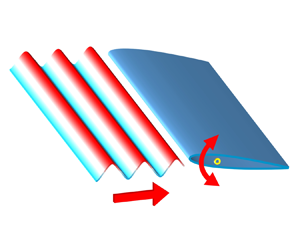Published online by Cambridge University Press: 30 April 2024

The response of airfoils to unsteady disturbances is a classic problem in the aerodynamics field. Many theoretical models have been proposed in the past to predict the unsteady aerodynamic forces of airfoils. However, these theories focused on individual airfoil motions or incoming flow disturbances, while the theoretical models for multiple disturbances still need to be developed. In this study, a theoretical model to predict the aerodynamic force of an oscillating airfoil encountering vertical gust is derived from a linear combination of Theodorsen's and Sears’ theories. Experimental investigations involving a two-dimensional pitching airfoil encountering a sinusoidal vertical gust are carried out to examine the proposed theory. It is found that the theory effectively captures the trends in the unsteady lift of airfoils subjected to dual disturbances. However, it tends to overestimate the lift amplitude. Notably, when a quasi-steady correction is applied to the theory, the prediction accuracy is greatly improved. The theory correction agrees well with experiment at small pitching frequencies, while deviations exist at higher pitching frequencies. The temporal evolution of the flow velocity reveals that the velocity disturbance induced by the coupled disturbance around the airfoil conforms to the linear superposition of the velocities induced by each individual disturbance, consistent with the prediction of the vortex sheet model. As the pitching frequency increases, significant nonlinear effects appear near the trailing edge of the airfoil, which may be one key factor for the disparities between the theoretical predictions and the experimental lift at higher pitching frequencies.
To send this article to your Kindle, first ensure no-reply@cambridge.org is added to your Approved Personal Document E-mail List under your Personal Document Settings on the Manage Your Content and Devices page of your Amazon account. Then enter the ‘name’ part of your Kindle email address below. Find out more about sending to your Kindle. Find out more about saving to your Kindle.
Note you can select to save to either the @free.kindle.com or @kindle.com variations. ‘@free.kindle.com’ emails are free but can only be saved to your device when it is connected to wi-fi. ‘@kindle.com’ emails can be delivered even when you are not connected to wi-fi, but note that service fees apply.
Find out more about the Kindle Personal Document Service.
To save this article to your Dropbox account, please select one or more formats and confirm that you agree to abide by our usage policies. If this is the first time you used this feature, you will be asked to authorise Cambridge Core to connect with your Dropbox account. Find out more about saving content to Dropbox.
To save this article to your Google Drive account, please select one or more formats and confirm that you agree to abide by our usage policies. If this is the first time you used this feature, you will be asked to authorise Cambridge Core to connect with your Google Drive account. Find out more about saving content to Google Drive.